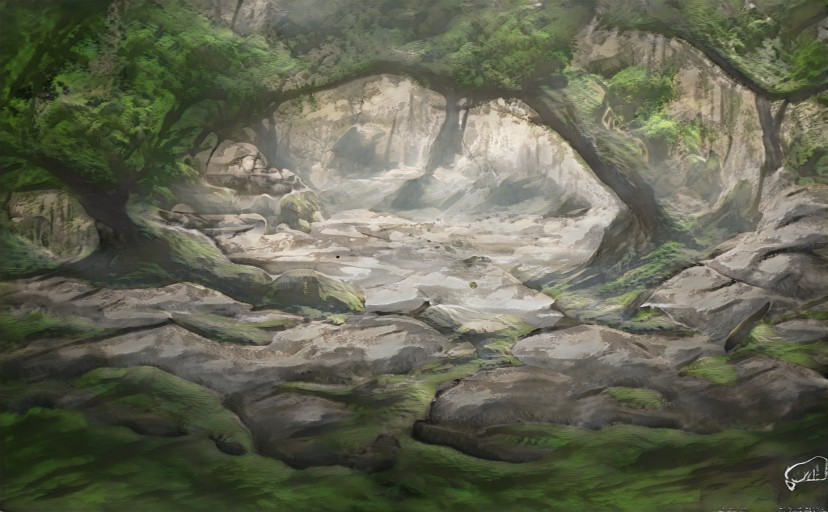Booming Hills Range
The Booming Hills Range (historically known by the Elovisians as the Gweise Range) are a series of close-packed, forested mountains and hills found on the Medial G1 cube face and partially on surrounding faces.
Only sparsely inhabited before the outbreak of the War of Reunification due to the geological instability of the region, the contestants in that war now fight a seemingly endless struggle - by land, by air, and even underground - over the rich ore veins found in the Booming Hills.
Geography
The Booming Hills themselves are a series of rolling foothills that extend all the way from the graggy heights of the Medial G1 vertex and edge mountains all the way to the commissure at the center of that face. Smaller ranges branch out from the edges and vertices, subdiving the G1 face into several different 'theaters.' Snow runoff from the mountains creates a network of center-flowing creeks and rivers in the valleys which crease the landscape.
The chill from the adjacent Medial D cube has caused the ground water and magma beneath Medial G1 to undergo cycles of cooling and expansion, creating the hills and branching mountain ranges found on this face. Underground aquifers and lava tubes constitute a maze of naturally-occuring caverns in the region, a fact which lends the region well to mining and the construction clandestine military outposts. In fact, due to human activities, the underground geography (often called the 'Booming Hills Connectome') is constantly shifting, as new tunnels are hewn out of the granite and old tunnels are collapsed by bombardment or sapping.
Similar foothills spill over onto Medial G1, G2, G3, and G4 faces, with the ultimate boundaries of the Booming Hills Range set by where the terrain evens out from eight to ten miles into these faces.
Localized Phenomena
During fall evenings, the narrow gaps created by the terrain and strong temperature differentials between the adjacent cubes (one being close to the hot Rostral Tesseract and the other being close to the coll Caudal Tesseract) creates howling winds which can damage surface constructions. Generally, these winds move away from the edges and towards the central commissure, though not always.
Fauna & Flora
The high altitudes, cool weather (relative to the rest of Medial G), and low cloud cover make the region ideal for alpine and sub-alpine organisms. Grasses and copses of evergreen trees litter the hills, with spruces and pines predominating. While ongoing human activities have destroyed some of the lowlying woodland, the inability to use fire to flush out enemy encampments (due to the Medial B Accords) has led combatants to preserve copses as natural rifleman blinds. The high mountain woods remain intact up to the treeline due to the difficulty of operating large wheeled or tracked vehicles in these rocky regions, with auto-armor being the preferred options for heavy fire support in these environments.
Mountain bluebirds and small mammals, including rabbits and squirrels, spend much of their time in these copses, while deer roam the more open, grassy hills. Deer populations are in decline due to hunting; venison can make a delicious addition to bland combat rations. Bobcats, mountain lions, and black bears are known to frequent the region, though the populations of these animals are also in decline due to the loss of large game and the occasional defensive shooting.
Natural Resources
While there is ample lumber on the surface, this is often left untouched due to the danger of logging efforts beneath the open sky and due to the woods' utility as concealment. Underground, vast veins of iron, silver, and gold make the region valuable for mining efforts.
History
The early Elovisians were forced out of Medial A by the then-new Voxelian Empire during the 6,100's AC. Some exiles eventually found their way to what would eventually become the Booming Hills Range, naming the place the Gweise Range and settling near the many rivers of the region. Threats from local predators and extreme seasonal winds made living in the Gweise Range difficult and kept the local population from growing beyond around 10,000 people. When the Free Faces League was established, most of these Elovisian settlers either integrated themselves into the larger nation or chose to remain freelanders within that nation's loose sphere of influence and protection.
Because of where it lies within the Medial Tesseract, the Booming Hills Range have become an ongoing site of contention between the adjacent Voxelian (with holdings on G4) and Free Faces League (with holdings on G2) states. The wealth of metal ores and spillover from the adjacent Medial D battlefields has only served to draw more conflict into the region as the War of Reunification has progressed into an interminable stalemate.
Alternative Name(s)
Gweise Range, Booming Hills
Location under
Contested By
Characters in Location




Comments